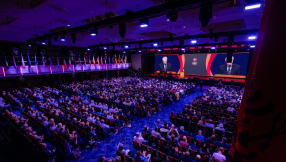
What can you do in 30 minutes? Perhaps you can clean up your room, take a long satisfying nap or grab a quick meal at a fast food restaurant.
Believe it or not, this may also be the amount of time needed to travel from Earth to Mars, if recent projections of a scientist from the National Aeronautics and Space Administration (NASA) proved correct and doable.
In a video blog for the space agency, scientist Phil Lubin revealed that NASA is working on laser propulsion technology which can enable a spacecraft to go from Earth to Mars in a span of three days.
This spacecraft currently being developed by the NASA would use a technology known to experts as "photonic propulsion." This technology will allow spaceships to explore space at 30 percent of the speed of light.
Lubin, however, predicted that with further technological advances, the travel time from Earth to Mars can further be cut to just half an hour.
The NASA scientist explained his computations and estimates in his paper published in the Journal of the British Interplanetary Society.
"As an example, on the eventual upper end, a full-scale (50-70 GW) DE-STAR 4 – Directed Energy System for Targeting of Asteroids and Exploration – will propel a wafer scale spacecraft with a one meter sail to about 26 percent the speed of light in about 10 minutes," Lubin explained, as quoted by The Express.
"[It would] reach Mars (1 AU) in 30 minutes, pass Voyager 1 in less than three days, pass 1,000 AU in 12 days and reach Alpha Centauri in about 15 years," he added.
To be able to accomplish the goal of traveling from Earth to Mars in just 30 minutes, a spacecraft would have to travel at a speed of 174.3 million miles an hour.
The bad news is that human beings cannot survive this high speed, which means that the plan, if ever it comes out of the drawing boards, would most likely involve sending robots to the Red Planet.
"Humans are extremely fragile and require a lot of support. Robotic missions are much better suited for interstellar exploration in the future," Lubin said.
"It turns out to get to relativistic speeds, just using different technology, it would take the same amount of energy for roughly the same amount of time," he added.

















